Qualitative Dynamics of Suspended Particulate Matter in the Changjiang Estuary from Geostationary Ocean Color Images: An Empirical, Regional Modeling Approach
Abstract
1. Introduction
2. Dataset and Methods
2.1. Study Area
2.2. Introduction of Dataset
2.2.1. Field Spectral and SPM Collection
2.2.2. GOCI Data
2.2.3. Ancillary Data
2.3. Aerosol Scattering Correction
2.4. GOCI Processing
- (1)
- Images with less cloud covering were selected by the browsing images included in every image zip file.
- (2)
- Using GDPS batch processing tool, all images were converted a to the Environment for Visualizing Images (ENVI) format to carry out following steps with some scripts in IDL (interface description language), which specializes in satellite data processing.
- (3)
- Making a binary mask to remove land areas and patches contaminated by clouds. The land mask keeps the same for the fixed scan area of GOCI and can be downloaded on the website, but the cloud cover was always different from each other. Here it was derived from its unsupervised classification results.
- (4)
- Using the proper atmospheric correction method to obtain satellite-derived Rrs from GOCI images. It’s worth noticing that solar zenith angles used in computing the transmissivity were obtained base on the general solar position calculation algorithms contributed by NOAA.
- (5)
- Several scripts developed in IDL were used to combine area, mask, re-project, clip, correct aerosol scattering, and calculate SPM concentration orderly.
- (6)
- Mapping SPM concentration from GOCI in our study area in ArcGIS.
2.5. Application of the GOCI Spectral Response Function for Field Spectral
2.6. Statistical Criteria for Model Evaluation
3. Results
3.1. Spectrum Characteristic Analysis
3.2. Regional Tuning Model for GOCI in the Changjiang Estuary
3.3. Model Validation
3.4. Application to GOCI Images
3.4.1. Atmospheric Correction
3.4.2. Diurnal Variation of SPM Mapped by GOCI
3.4.3. Monthly Variation of SPM Mapped by GOCI
4. Discussion
4.1. Factors for SPM Retrieval Accuracy
4.2. Driving Forces on SPM Variation
5. Conclusions
- (1)
- The atmospheric correction algorithm (UV-AC) proposed by He et al. [42] has been further validated with field data measured in the East China Sea, showing its potential in coastal turbidity waters. On the basis of the UV-AC algorithm, the GOCI level 2C data that have been corrected with Rayleigh scattering can be used for other studies in monitoring oceanic dynamics after a simpler process.
- (2)
- The empirical model with variable of Rrs745/Rrs490 performed the best with whole range of SPM concentration. Comparison between the models estimated and the measured SPM shows that the modified model is of higher accuracy than other models for the application in the Changjiang Estuary. The validation results of two kinds of validation dataset, field measured and satellite-derived, indicated that the empirical algorithm calibrated in this paper can compute reliable SPM concentration for turbid coastal waters in the Changjiang Estuary. However, the algorithm gives a poor performance in offshore waters with lower SPM concentration (SPM < 35 mg/L), due to the increasing proportion of organic materials (biomass debris and phytoplankton) in suspended particle.
- (3)
- Comparing with the daily eight images served by GOCI, we found that tide is the main driver for the diurnal variation of SPM in the Changjiang Estuary. Especially, waters near the estuary respond well with tidal elevation. Due to the diversity of phase and swing, the variation of SPM concentration during the daytime is diverse.
- (4)
- The higher SPM concentration in dry seasons was more likely contributed by sediment resuspended from the sea bed for the less sediment discharged from the Changjiang River. Wind induced mixing also plays a key role in sediment resuspension to cause the increase of SPM concentration in surface layer.
- (1)
- It is necessary to partition SPM in future research. The weak relation between Rrs and SPM concentration in slightly and moderately turbid waters could only be solved by separate feature analysis on PIM and POM.
- (2)
- The physical, geological, chemical and biological processes in the study area are so complex that we need more data to analyze the mechanisms of SPM variation spatially and temporally.
Author Contributions
Funding
Acknowledgments
Conflicts of Interest
References
- Gordon, H.R.; McCluney, W.R. Estimation of the depth of sunlight penetration in the sea for remote sensing. Appl. Opt. 1975, 14, 413–416. [Google Scholar] [CrossRef] [PubMed]
- Cloern, J.E. Turbidity as a control on phytoplankton biomass and productivity in estuaries. Cont. Shelf Res. 1987, 7, 1367–1381. [Google Scholar] [CrossRef]
- Bowers, D.G.; Binding, C.E. The optical properties of mineral suspended particles: A review and synthesis. Estuar. Coast. Shelf Sci. 2006, 67, 219–230. [Google Scholar] [CrossRef]
- Zhao, H.; Chen, Q.; Walker, N.D.; Zheng, Q.; MacIntyre, H.L. A study of sediment transport in a shallow estuary using MODIS imagery and particle tracking simulation. Int. J. Remote Sens. 2011, 32, 6653–6671. [Google Scholar] [CrossRef]
- Turner, A.; Millward, G.E. Suspended particles: Their role in estuarine biogeochemical cycles. Estuar. Coast. Shelf Sci. 2002, 55, 857–883. [Google Scholar] [CrossRef]
- Komick, N.M.; Costa MP, F.; Gower, J. Bio-optical algorithm evaluation for MODIS for western Canada coastal waters: An exploratory approach using in situ reflectance. Remote Sens. Environ. 2009, 113, 794–804. [Google Scholar] [CrossRef]
- Novoa, S.; Doxaran, D.; Ody, A.; Lafon, V.; Lubac, B.; Gernez, P. Atmospheric Corrections and Multi-Conditional Algorithm for Multi-Sensor Remote Sensing of Suspended Particulate Matter in Low-to-High Turbidity Levels Coastal Waters. Remote Sens. 2017, 9. [Google Scholar] [CrossRef]
- Petus, C.; Marieu, V.; Novoa, S.; Chust, G.; Bruneau, N.; Froidefond, J.M. Monitoring spatio-temporal variability of the Adour River turbid plume (Bay of Biscay, France) with MODIS 250-m imagery. Cont. Shelf Res. 2014, 74, 35–49. [Google Scholar] [CrossRef]
- Lorthiois, T.; Chami, M. Daily and seasonal dynamics of suspended particles in the Rhône River plume based on remote sensing and field optical measurements. Geo-Mar. Lett. 2012, 32, 89–101. [Google Scholar] [CrossRef]
- Chen, S.; Han, L.; Chen, X.; Li, D.; Sun, L.; Li, Y. Estimating wide range Total Suspended Solids concentrations from MODIS 250-m imageries: An improved method. ISPRS J. Photogramm. Remote Sens. 2015, 99. [Google Scholar] [CrossRef]
- Zhang, M.W.; Tang, J.W.; Dong, Q.; Song, Q.; Ding, J. Retrieval of total suspended matter concentration in the Yellow and East China Seas from MODIS imagery. Remote Sens. Environ. 2010, 114, 392–403. [Google Scholar] [CrossRef]
- Lahet, F.; Stramski, D. MODIS imagery of turbid plumes in San Diego coastal waters during rainstorm events. Remote Sens. Environ. 2010, 114, 332–344. [Google Scholar] [CrossRef]
- Hopkins, J.; Lucas, M.; Dufau, C.; Sutton, M.; Stum, J.; Lauret, O.; Channelliere, C. Detection and variability of the Congo River plume from satellite derived sea surface temperature, salinity, ocean colour and sea level. Remote Sens. Environ. 2013, 139, 365–385. [Google Scholar] [CrossRef]
- Chen, X.; Han, X.; Feng, L. Towards a practical remote-sensing model of suspended sediment concentrations in turbid waters using MERIS measurements. Int. J. Remote Sens. 2015, 36, 3875–3889. [Google Scholar] [CrossRef]
- Raag, L.; Uiboupin, R.; Sipelgas, L. Analysis of historical MERIS and MODIS data to evaluate the impact of dredging to monthly mean surface TSM concentration. In Proceedings of the SPIE—The International Society for Optical Engineering, San Francisco, CA, USA, 2–7 February 2013; Volume 8888. [Google Scholar]
- Han, B.; Loisel, H.; Vantrepotte, V.; Mériaux, X.; Bryère, P.; Ouillon, S.; Dessailly, D.; Xing, Q.; Zhu, J. Development of a Semi-Analytical Algorithm for the Retrieval of Suspended Particulate Matter from Remote Sensing over Clear to Very Turbid Waters. Remote Sens. 2016, 8, 211. [Google Scholar] [CrossRef]
- Ryu, J.H.; Choi, J.K.; Eom, J.; Ahn, J.H. Temporal variation in Korean coastal waters using Geostationary Ocean Color Imager. J. Coast. Res. 2011, 1731–1735. [Google Scholar]
- Binding, C.E.; Bowers, D.G.; Mitchelson-Jacob, E.G. Estimating suspended sediment concentrations from ocean colour measurements in moderately turbid waters; the impact of variable particle scattering properties. Remote Sens. Environ. 2005, 94, 373–383. [Google Scholar] [CrossRef]
- He, X.; Bai, Y.; Pan, D.; Huang, N.; Dong, X.; Chen, J.; Chen, C.; Cui, Q. Using geostationary satellite ocean color data to map the diurnal dynamics of suspended particulate matter in coastal waters. Remote Sens. Environ. 2013, 133, 225–239. [Google Scholar] [CrossRef]
- Kumar, A.; Equeenuddin, S.M.; Mishra, D.R.; Acharya, B. C. Remote monitoring of sediment dynamics in a coastal lagoon: Long-term spatio-temporal variability of suspended sediment in Chilika. Estuar. Coast. Shelf Sci. 2016, 170, 155–172. [Google Scholar] [CrossRef]
- Huang, C.; Yang, H.; Zhu, A.X.; Zhang, M.; Lü, H.; Huang, T.; Zou, J.; Li, Y. Evaluation of the Geostationary Ocean Color Imager GOCI to monitor the dynamic characteristics of suspension sediment in Taihu Lake. Int. J. Remote Sens. 2015, 36, 3859–3874. [Google Scholar] [CrossRef]
- Choi, J.K.; Park, Y.J.; Ahn, J.H.; Lim, H. S.; Eom, J.; Ryu, J.H. GOCI, the world’s first geostationary ocean color observation satellite, for the monitoring of temporal variability in coastal water turbidity. J. Geophys. Res. Oceans 2012, 117. [Google Scholar] [CrossRef]
- Qiu, Z. A simple optical model to estimate suspended particulate matter in Yellow River Estuary. Opt. Express 2013, 21, 27891. [Google Scholar] [CrossRef] [PubMed]
- Siswanto, E.; Tang, J.; Yamaguchi, H.; Ahn, Y.H.; Ishizaka, J.; Yoo, S.; Kim, S.W.; Kiyomoto, Y.; Yamada, K.; Chiang, C.; Kawamura, H. Empirical ocean-color algorithms to retrieve chlorophyll- a, total suspended matter, and colored dissolved organic matter absorption coefficient in the Yellow and East China Seas. J. Oceanogr. 2011, 67, 627. [Google Scholar] [CrossRef]
- Dorji, P.; Fearns, P.; Broomhall, M. A Semi-Analytic Model for Estimating Total Suspended Sediment Concentration in Turbid Coastal Waters of Northern Western Australia Using MODIS-Aqua 250 m Data. Remote Sens. 2016, 8. [Google Scholar] [CrossRef]
- Chen, J.; D’Sa, E.; Cui, T.; Zhang, X. A semi-analytical total suspended sediment retrieval model in turbid coastal waters: A case study in Changjiang River Estuary. Opt. Express 2013, 21, 13018–13031. [Google Scholar] [CrossRef] [PubMed]
- Stavn, R.H.; Richter, S.J. Biogeo-optics: Particle optical properties and the partitioning of the spectral scattering coefficient of ocean waters. Appl. Opt. 2008, 47, 2660–2679. [Google Scholar] [CrossRef] [PubMed]
- Long, C.M.; Pavelsky, T.M. Remote sensing of suspended sediment concentration and hydrologic connectivity in a complex wetland environment. Remote Sens. Environ. 2013, 129, 197–209. [Google Scholar] [CrossRef]
- Milliman, J.D.; Syvitski JP, M. Geomorphic/Tectonic Control of Sediment Discharge to the Ocean: The Importance of Small Mountainous Rivers. J. Geol. 1992, 100, 525–544. [Google Scholar] [CrossRef]
- Xu, K.; Milliman, J.D. Seasonal variations of sediment discharge from the Yangtze River before and after impoundment of the Three Gorges Dam. Geomorphology 2009, 104, 276–283. [Google Scholar] [CrossRef]
- Yan, X.H.; Jo, Y.H.; Jiang, L.; Wan, Z.; Liu, W. T., Li; Zhan, J.; Du, T. Impact of the Three Gorges Dam water storage on the Yangtze River outflow into the East China Sea. Geophys. Res. Lett. 2008, 35, 544–548. [Google Scholar] [CrossRef]
- Wu, Y.; Zhang, J.; Liu, S.M.; Zhang, Z.F.; Yao, Q.Z.; Hong, G.H.; Cooper, L. Sources and distribution of carbon within the Yangtze River system. Estuar. Coast. Shelf Sci. 2007, 71, 13–25. [Google Scholar] [CrossRef]
- Xie, D.F.; Wang, Z.B.; Shu, G.; De Vriend, H.J. Modeling the tidal channel morphodynamics in a macro-tidal embayment, Hangzhou Bay, China. Cont. Shelf Res. 2009, 29, 1757–1767. [Google Scholar] [CrossRef]
- Mueller, J.L.; Davis, C.O.; Arnone, R.A.; Frouin, R.; Carder, K.L.; Lee, Z.P.; Steward, R.G.; Hooker, S.; Mobley, C.D.; McClain, C.R. Above-water radiance and remote sensing measurement and analysis protocols. In Ocean Optics Protocols for Satellite Ocean-Color Sensor Validation, vol. Revision 4, III: Radiometric Measurements and Data Analysis Protocols; NASA Tech. Memo; Goddard Space Flight Space Center: Greenbelt, MD, USA, 2003. [Google Scholar]
- Mobley, C.D. Estimation of the remote-sensing reflectance from above-surface measurements. Appl. Opt. 1999, 38, 7442–7455. [Google Scholar] [CrossRef] [PubMed]
- Strickland, J.D.H.; Parsons, T.R. A practical handbook of seawater analysis. Fisheries Research Board of Canada. Q. Rev. Biol. 1969. [Google Scholar] [CrossRef]
- Atlas, R.; Hoffman, R.N.; Ardizzone, J.; Leidner, S.M.; Jusem, J.C.; Smith, D.K.; Gombos, D. A Cross-calibrated, Multiplatform Ocean Surface Wind Velocity Product for Meteorological and Oceanographic Applications. Bull. Am. Meteorol. Soc. 2011, 92, 157–174. [Google Scholar] [CrossRef]
- Wang, M. Validation study of the SeaWiFS oxygen A-band absorption correction: Comparing the retrieved cloud optical thicknesses from SeaWiFS measurements. Appl. Opt. 1999, 38, 937. [Google Scholar] [CrossRef] [PubMed]
- Wang, M. Atmospheric Correction for Remotely-Sensed Ocean-Colour Products; Reports and Monographs of the International Ocean-Colour Coordinating Group (IOCCG); IOCCG: Dartmouth, NS, Canada, 2010. [Google Scholar]
- Wang, M. Remote sensing of the ocean contributions from ultraviolet to near-infrared using the shortwave infrared bands: Simulations. Appl. Opt. 2007, 46, 1535–1547. [Google Scholar] [CrossRef] [PubMed]
- Ahn, J.H.; Park, Y.J.; Ryu, J.H.; Lee, B. Development of atmospheric correction algorithm for Geostationary Ocean Color Imager (GOCI). Ocean Sci. J. 2012, 47, 247–259. [Google Scholar] [CrossRef]
- He, X.; Bai, Y.; Pan, D.; Tang, J.; Wang, D. Atmospheric correction of satellite ocean color imagery using the ultraviolet wavelength for highly turbid waters. Opt. Expraess 2012, 20, 20754–20770. [Google Scholar] [CrossRef] [PubMed]
- Tzortziou, M.; Neale, P.J.; Osburn, C.L.; Megonigal, J.P.; Maie, N.; Jaffé, R. Tidal marshes as a source of optically and chemically distinctive colored dissolved organic matter in the Chesapeake Bay. Limnol. Oceanogr. 2008, 53, 148–159. [Google Scholar] [CrossRef]
- Gordon, H.R. Remote sensing of ocean color: A methodology for dealing with broad spectral bands and significant out-of-band response. Appl. Opt. 1995, 34, 8363. [Google Scholar] [CrossRef] [PubMed]
- Shi, W.; Wang, M. Satellite observations of the seasonal sediment plume in central East China Sea. J. Mar. Syst. 2010, 82, 280–285. [Google Scholar] [CrossRef]
- Yuan, D.; Zhu, J.; Li, C.; Hu, D. Cross-shelf circulation in the Yellow and East China Seas indicated by MODIS satellite observations. J. Mar. Syst. 2008, 70, 134–149. [Google Scholar] [CrossRef]
- Dong, L.X.; Guan, W.B.; Chen, Q.; Li, X. H.; Liu, X. H.; Zeng, X. M. Sediment transport in the Yellow Sea and East China Sea. Estuar. Coast. Shelf Sci. 2011, 93, 248–258. [Google Scholar] [CrossRef]
- Luo, Z.; Zhu, J.; Wu, H.; Li, X. Dynamics of the Sediment Plume Over the Yangtze Bank in the Yellow and East China Seas. J. Geophys. Res. 2017, 122. [Google Scholar] [CrossRef]
- Röttgers, R.; Heymann, K.; Krasemann, H. Suspended matter concentrations in coastal waters: Methodological improvements to quantify individual measurement uncertainty. Estuar. Coast. Shelf Sci. 2014, 151, 148–155. [Google Scholar]
- Stavn, R.H.; Rick, H.J.; Falster, A.V. Correcting the errors from variable sea salt retention and water of hydration in loss on ignition analysis: Implications for studies of estuarine and coastal waters. Estuar. Coast. Shelf Sci. 2009, 81, 575–582. [Google Scholar] [CrossRef]
- Bowers, D.G.; Braithwaite, K.M.; Nimmosmith WA, M.; Graham, G.W. Light scattering by particles suspended in the sea: The role of particle size and density. Cont. Shelf Res. 2009, 29, 1748–1755. [Google Scholar] [CrossRef]
- Gordon, H.R.; Wang, M. Retrieval of water-leaving radiance and aerosol optical thickness over the oceans with SeaWiFS: A preliminary algorithm. Appl. Opt. 1994, 33, 443–452. [Google Scholar] [CrossRef] [PubMed]
- Chen, S.; Zhang, G.; Yang, S.; Yu, Z. Temporal and spatial changes of suspended sediment concentration and resuspension in the Yangtze River Estuary and its adjacent waters. Acta Geogr. Sin. 2004, 59, 260–266. [Google Scholar]
- Rong, Z.; Li, M. Tidal effects on the bulge region of Changjiang River plume. Estuar. Coast. Shelf Sci. 2012, 97, 149–160. [Google Scholar] [CrossRef]
- Xie, Q.C.; Zhang, L.F.; Zhou, F.G. Features and transportation of suspended matter over the continental shelf off the Changjiang Estuary. Proceeding of the International Symposium on the Sedimentation on the Continental Shelf, with Special Reference to the East China Sea, Hangzhou, China, 12–16 April 1983; China Ocean Press: Beijing, China, 1983; pp. 400–412. [Google Scholar]
- Shen, H.T.; Pan, D.A. Turbidity Maximum in the Changjiang Estuary; China Ocean: Beijing, China, 2001. [Google Scholar]
- Bian, C.; Jiang, W.; Quan, Q.; Wang, T.; Greatbatch, R.J.; Li, W. Distributions of suspended sediment concentration in the Yellow Sea and the East China Sea based on field surveys during the four seasons of 2011. J. Mar. Syst. 2013, 121–122, 24–35. [Google Scholar] [CrossRef]
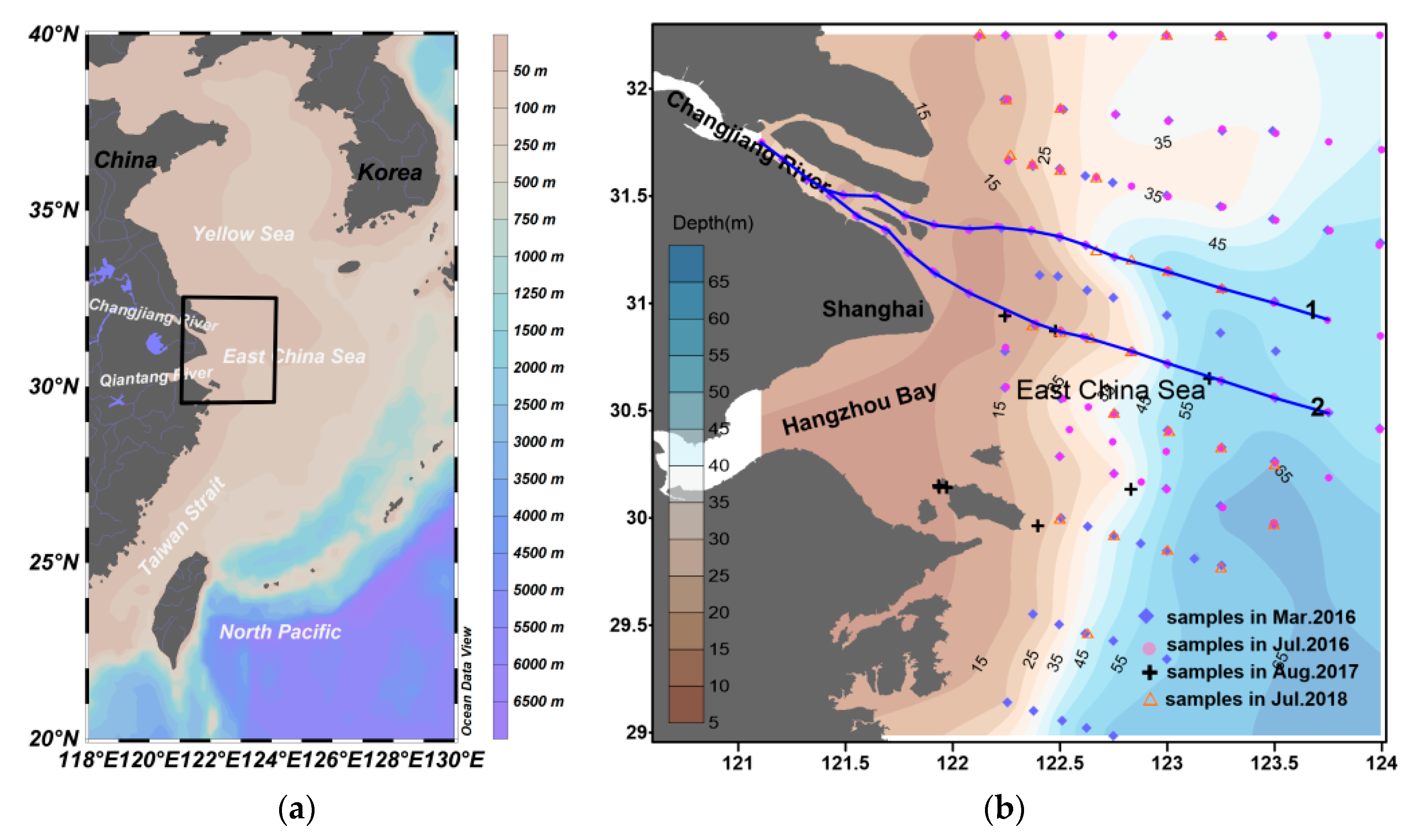



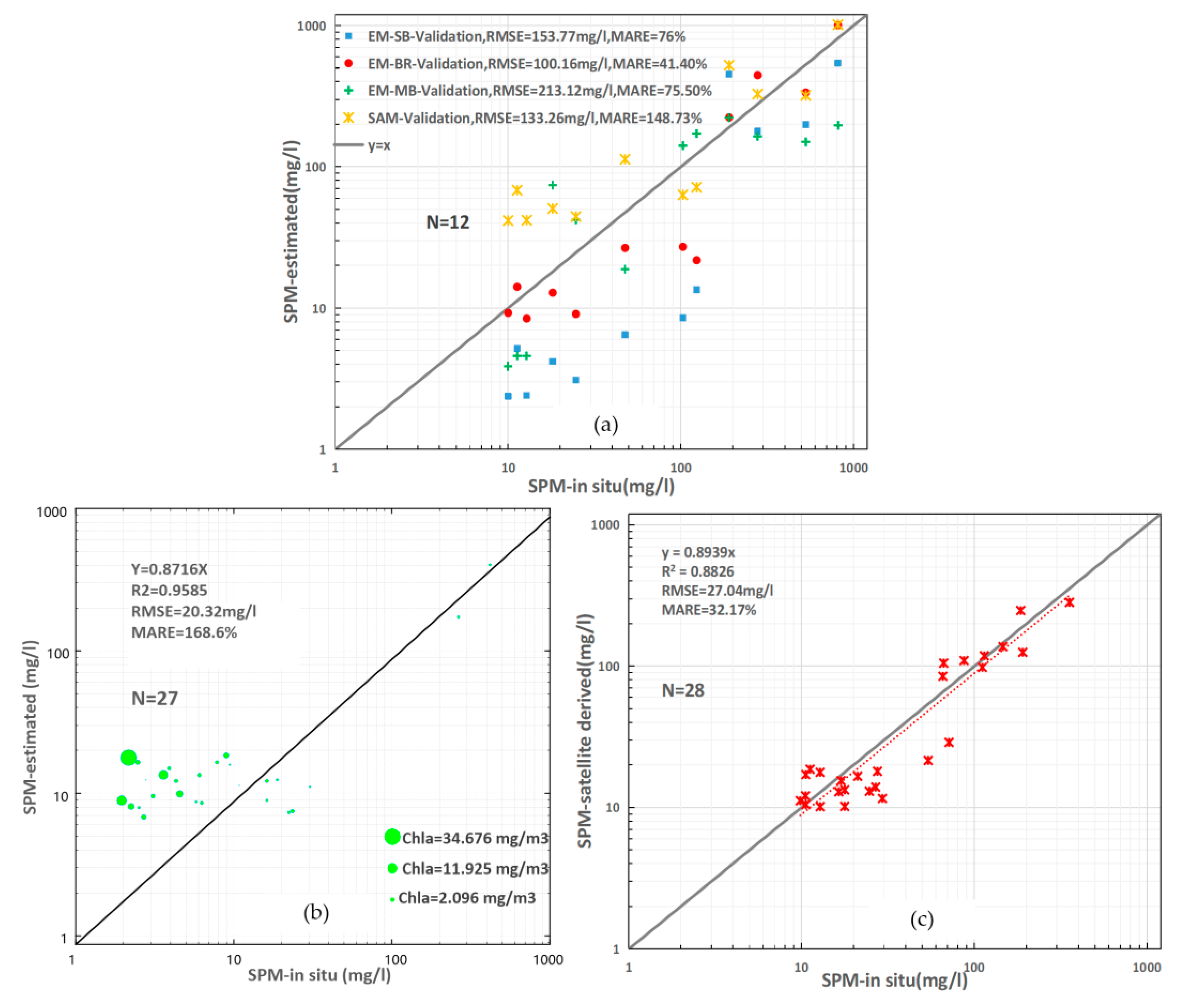
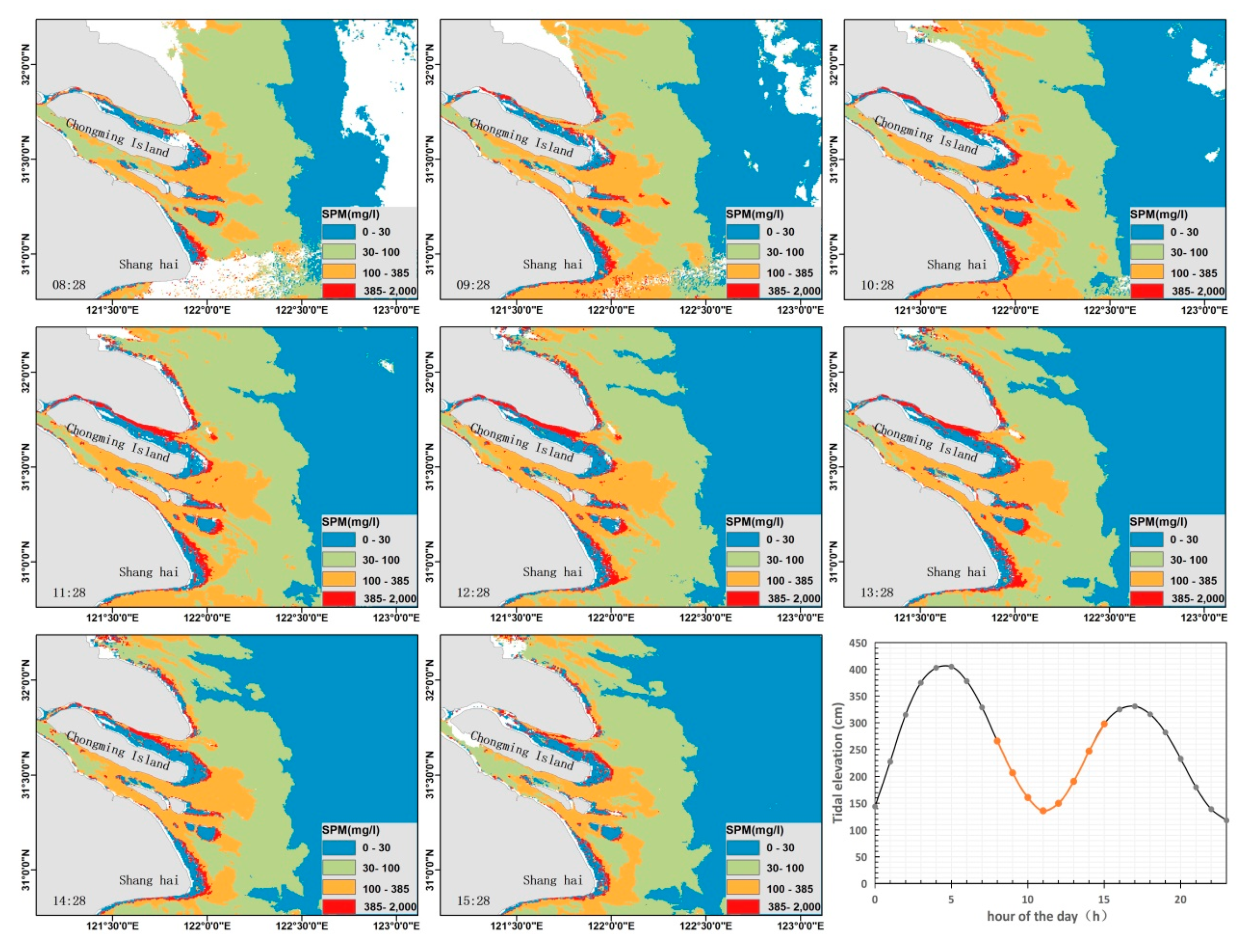


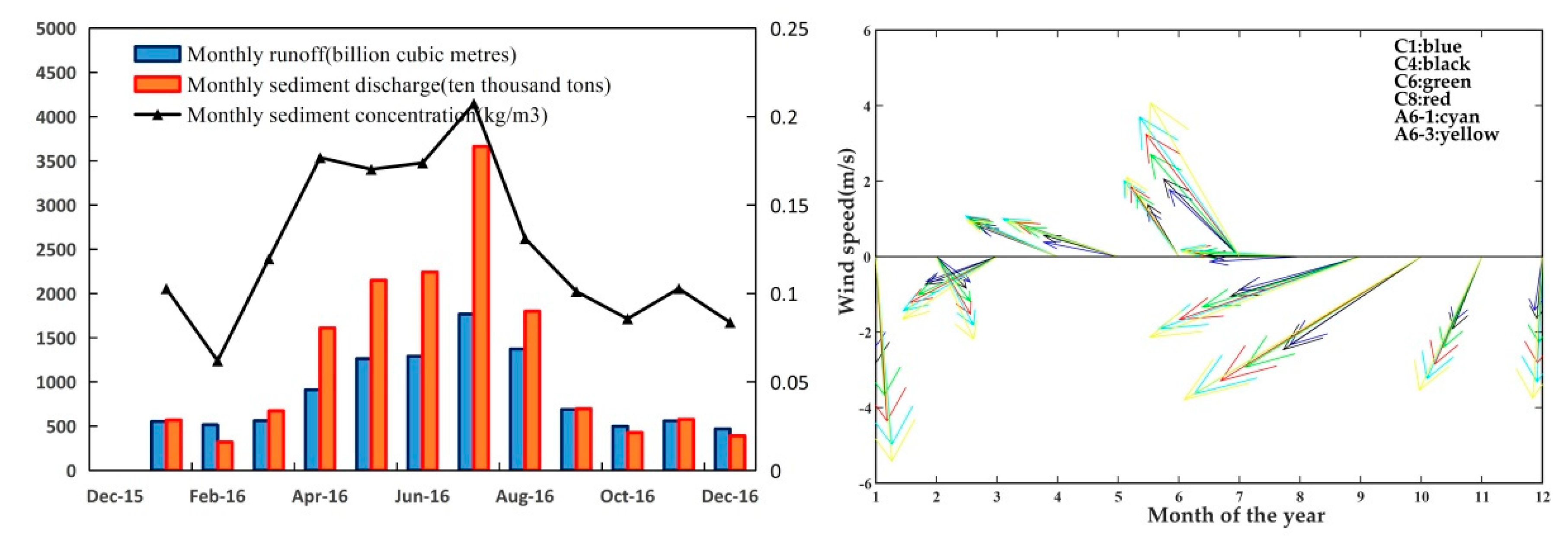
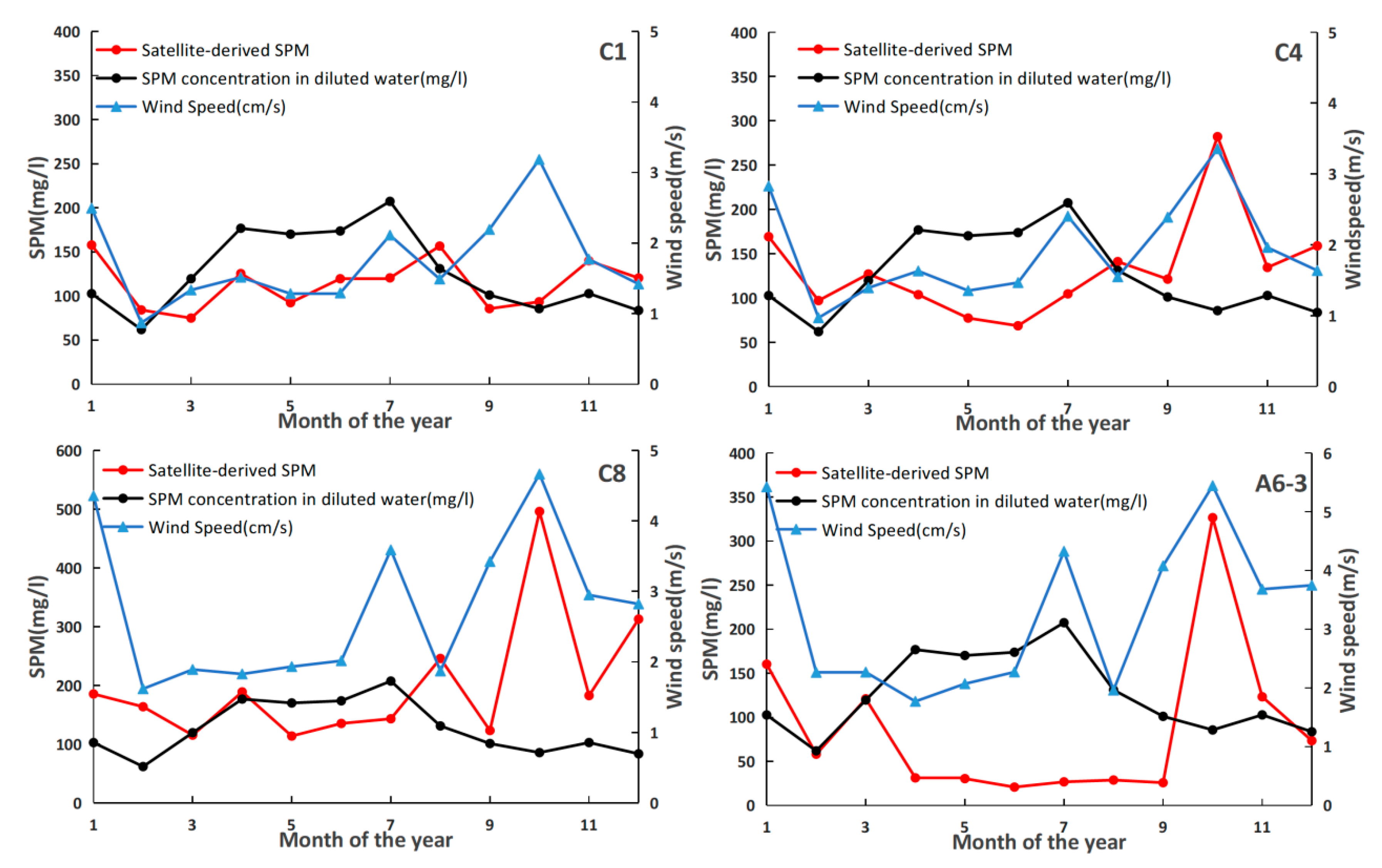
| References | Band(s) | Model | SPM Range(g/m3) | R2 | Study Area |
|---|---|---|---|---|---|
| Huang et al. (2015) [21] | Rrs(745) Rrs(680) Rrs(555) | 5–300 | 0.81 0.83 | Taihu Lake China | |
| Chio et al. [22] (2012) | Rrs(660) | 1.88–183.1 | 0.9339 | coastal zone adjacent to the city of Mokpo | |
| He et al. [19] (2013) | Rrs(745) Rrs(490) | 8–5275 | 0.96 | Changjiang Estuary and Hang zhou Bay | |
| Zhongfeng Qiu [23] | Rrs(680) Rrs(555) | 1.9–1896.5 | 0.95 | Yellow river estuary | |
| Zhang et al. [11] Siswanto et al. [24] | Rrs(645) Rrs(555) Rrs(488) | 0.66–300 | / | The Yellow and East China Sea | |
| Chen et al. [26] | Rrs(865) Rrs(765) | 100–800 | 0.876–0.8917 | Changjiang River Estuary |
| Max | Min | Average | STDEV | |
|---|---|---|---|---|
| 1. Calibration dataset measured in March and July, 2016 and August 2017, respectively, 48 stations | ||||
| SPM (mg/) | 2061.25 | 10.54 | 209.35 | 353.68 |
| Chla (mg/m3) | 13.17 | 0.05 | 1.33 | 2.16 |
| Salinity (psu) | 33.85 | 0.14 | 25.29 | 10.14 |
| 2. Validation dataset measured in March and July, 2016 and August 2017, respectively, 12 stations | ||||
| SPM (mg/L) | 812.70 | 10.02 | 180.05 | 251.19 |
| Chla (mg/m3) | 3.04 | 0.06 | 0.92 | 0.85 |
| Salinity (psu) | 32.61 | 0.71 | 21.37 | 11.88 |
| 3. Validation dataset measured in July 2018, 28 stations | ||||
| SPM (mg/L) | 420.50 | 1.94 | 33.49 | 91.97 |
| Chla (mg/m3) | 34.68 | 0.18 | 4.15 | 6.90 |
| Wavelength | GOCI-AC | UV-AC | ||||
|---|---|---|---|---|---|---|
| RMSE (sr−1) | MARE (%) | r | RMSE (sr−1) | MARE (%) | r | |
| 412 nm | 0.00644 | 29.14 | 0.28020 | 0.00612 | 26.85 | 0.21527 |
| 443 nm | 0.00778 | 26.54 | 0.18683 | 0.00705 | 16.71 | 0.26685 |
| 490 nm | 0.00944 | 19.68 | 0.19588 | 0.00870 | 14.39 | 0.27601 |
| 555 nm | 0.01113 | 10.39 | 0.35722 | 0.01046 | 16.32 | 0.43746 |
| 660 nm | 0.00885 | 27.05 | 0.60132 | 0.00767 | 14.23 | 0.68263 |
| 680 nm | 0.00889 | 30.57 | 0.59925 | 0.00760 | 14.77 | 0.69191 |
| 745 nm | 0.00561 | 39.17 | 0.09856 | 0.00575 | 32.44 | 0.54125 |
© 2018 by the authors. Licensee MDPI, Basel, Switzerland. This article is an open access article distributed under the terms and conditions of the Creative Commons Attribution (CC BY) license (http://creativecommons.org/licenses/by/4.0/).
Share and Cite
Shang, D.; Xu, H. Qualitative Dynamics of Suspended Particulate Matter in the Changjiang Estuary from Geostationary Ocean Color Images: An Empirical, Regional Modeling Approach. Sensors 2018, 18, 4186. https://doi.org/10.3390/s18124186
Shang D, Xu H. Qualitative Dynamics of Suspended Particulate Matter in the Changjiang Estuary from Geostationary Ocean Color Images: An Empirical, Regional Modeling Approach. Sensors. 2018; 18(12):4186. https://doi.org/10.3390/s18124186
Chicago/Turabian StyleShang, Dinghui, and Huiping Xu. 2018. "Qualitative Dynamics of Suspended Particulate Matter in the Changjiang Estuary from Geostationary Ocean Color Images: An Empirical, Regional Modeling Approach" Sensors 18, no. 12: 4186. https://doi.org/10.3390/s18124186
APA StyleShang, D., & Xu, H. (2018). Qualitative Dynamics of Suspended Particulate Matter in the Changjiang Estuary from Geostationary Ocean Color Images: An Empirical, Regional Modeling Approach. Sensors, 18(12), 4186. https://doi.org/10.3390/s18124186




